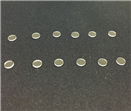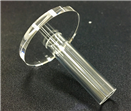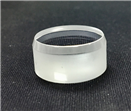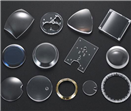

Time:2025-07-02
Sapphire high-strength glass, as an engineering material, exhibits high chemical stability and can effectively resist corrosion from various acids, alkalis, and solvents. Therefore, it is widely used in many demanding industrial fields. Its unique crystal structure and chemical composition endow it with excellent corrosion resistance, making it an ideal choice for harsh chemical environments.
The main component of sapphire is aluminum oxide (Al ? O ∝), with a crystal structure of alpha alumina, which is a very stable compound. This structure makes it almost non reactive with common acids, bases, and organic solvents at room temperature. For example, in laboratory tests, sapphire exhibits high stability in concentrations of 98% sulfuric acid, 37% hydrochloric acid, and 65% nitric acid. Even under high temperature conditions, its corrosion rate is much lower than that of ordinary glass or other engineering materials. In addition, it also has strong resistance to strong bases such as sodium hydroxide and potassium hydroxide, which is particularly important in chemical equipment and high-precision instruments.
The chemical stability of sapphire high-strength glass is not only reflected in its resistance to single reagents, but also in its adaptability to complex chemical environments. In many industrial scenarios, materials need to face the erosion of multiple chemical substances simultaneously. For example, in the semiconductor manufacturing process, they need to withstand the alternating effects of etching gases, strong acids, and strong bases. Due to its high purity and dense crystal structure, it can maintain stable performance under such harsh conditions, avoiding performance degradation or failure caused by corrosion.

In addition to its resistance to acid and alkali, sapphire also has outstanding corrosion resistance to organic solvents. Common organic solvents such as acetone, ethanol, xylene, etc. have almost no effect on it, which makes sapphire high-strength glass widely used in petrochemical, pharmaceutical, and laboratory equipment. For example, in the process of oil extraction, it can be used to manufacture corrosion-resistant observation windows and sensor components, ensuring long-term stable operation of equipment in environments rich in hydrogen sulfide and organic solvents.
The chemical stability of sapphire high-strength glass is closely related to its surface properties. Compared with other materials, sapphire has a smooth surface and is less prone to contamination, which reduces the possibility of chemical substances adhering and penetrating on its surface. Meanwhile, its high hardness and wear resistance further enhance its durability in harsh environments. For example, in the field of optics, it is commonly used to manufacture high-precision lenses and windows, and even if exposed to corrosive environments for a long time, their optical performance will not decrease due to surface corrosion.
It is worth mentioning that the chemical stability of sapphire high-strength glass is closely related to its preparation process. Sapphire prepared by high-temperature melting or crystal growth methods has higher purity and fewer defects, thereby further improving its corrosion resistance. For example, sapphire single crystals grown by Czochralski method have better chemical stability than polycrystalline or sintered alumina materials. This high standard preparation process ensures the reliability of sapphire glass in applications.
The performance of sapphire high-strength glass in terms of chemical stability makes it a material suitable for harsh chemical environments. Its wide range of applications, from industrial equipment to high-tech products, fully demonstrates its unique value. With the continuous development of technology, the performance of sapphire glass will be further improved, bringing changes to more fields.






Tel
Mobile phone
Customer service
TOP